Rogers Morton
Rogers Clark Ballard Morton (* 19. September 1914 in Louisville, Kentucky; † 19. April 1979 bei Easton, Maryland) war ein US-amerikanischer Politiker, der unter den Präsidenten Richard Nixon und Gerald Ford Innenminister sowie unter Ford auch Handelsminister der Vereinigten Staaten war. Außerdem vertrat er den 1. Kongresswahlbezirk von Maryland im Repräsentantenhaus.
Werdegang
Morton erreichte 1937 den Bachelor of Arts an der Yale University und diente im Zweiten Weltkrieg bei der United States Army, wo er den Rang eines Captain erreichte. Von 1939 bis 1951 arbeitete er bei der Ballard and Ballard Company, der er ab 1947 als Firmenchef vorstand.[1]
Anfang der 1950er-Jahre zog Morton von Kentucky auf eine Farm ins Eastern Shore von Maryland. Von 1963 bis 1971 vertrat er Maryland im Repräsentantenhaus der Vereinigten Staaten. 1968 spielte er eine führende Rolle in Richard Nixons erfolgreicher Präsidentschaftskandidatur und wurde 1969 von diesem als Vorsitzender des Republican National Committee eingesetzt.
Bei den Wahlen von 1970 wurden Morton gute Chancen auf eine Ablösung von Joseph Tydings als Senator für Maryland zugeschrieben; er entschied sich jedoch, weiterhin den Vorsitz des Republican National Committee zu behalten.
Am 29. Januar 1971 wurde Morton der 39. Innenminister der Vereinigten Staaten. In seine Amtszeit fielen der Bau der Trans-Alaska-Pipeline, die Ölkrise von 1973 sowie die Anfänge des Alaska National Interest Lands Conservation Act. Er war der einzige von der Ostküste stammende Innenminister während des 20. Jahrhunderts.[2]
Nach Nixons Rücktritt infolge der Watergate-Affäre blieb Morton bis 30. April 1975 auch unter Gerald Ford in seinem Amt. Im Anschluss war er vom 1. Mai 1975 bis zum 2. Februar 1976 der 22. Handelsminister der Vereinigten Staaten. Von April bis August 1976 arbeitete er als Wahlkampf-Manager für Ford und trat nach dessen Niederlage von seinen politischen Ämtern zurück. Drei Jahre später starb er auf seiner Farm in Maryland an Krebs.
Rogers Mortons Bruder Thruston Ballard war ebenfalls Politiker der Republikanischen Partei und gehörte beiden Kammern des US-Kongresses an.
Einzelnachweise
- ↑ American President: Rogers C. B. Morton (Memento des Originals vom 31. Juli 2009 im Internet Archive) Info: Der Archivlink wurde automatisch eingesetzt und noch nicht geprüft. Bitte prüfe Original- und Archivlink gemäß Anleitung und entferne dann diesen Hinweis. auf millercenter.org
- ↑ Twentieth Century Headliners and Highlights auf nps.gov
Weblinks
- Rogers Morton in der Notable Names Database (englisch)
- Rogers Morton im Miller Center of Public Affairs der University of Virginia (englisch)
- Rogers Morton im Biographical Directory of the United States Congress (englisch)
| Personendaten | |
|---|---|
| NAME | Morton, Rogers |
| ALTERNATIVNAMEN | Morton, Rogers Clark Ballard (vollständiger Name) |
| KURZBESCHREIBUNG | US-amerikanischer Politiker |
| GEBURTSDATUM | 19. September 1914 |
| GEBURTSORT | Louisville, Kentucky |
| STERBEDATUM | 19. April 1979 |
| STERBEORT | bei Easton, Maryland |
Auf dieser Seite verwendete Medien
Unofficial seal of the United States House of Representatives, based directly on the Great Seal of the United States. The official seal depicts the House side of the Capitol building,[1] but this is still a commonly seen symbol.
Party Logo
Seal of the United States Department of the Interior.
The seal consists of a male bison with the head and body in a left position, standing on a prairie, with mountains and a rising sun in the background, enclosed within two concentric circles, having the words "U.S. Department of the Interior" and the date "March 3, 1849" (when Congress created the department) inscribed in the top and bottom arcs within these circles. See here for more information.
The bison seal dates from 1917, when it was used as the emblem on the initial department flag and thereafter replaced the old version of the seal, which used a federal eagle. The eagle was reinstated for a few years in the 1920s, and a different seal was used from 1968-69, but on both occasions the bison seal was reinstated. For more information see this chapter in The Department of Everything Else: Highlights of Interior History.Seal of the United States Department of Commerce.
The seal was approved on April 4, 1913 and is derived from the seal of the defunct United States Department of Commerce and Labor. It is composed of the arms (Per fesse azure and or, a ship in full sail on waves of the sea, in chief proper; and in base a lighthouse illumined proper), and crest ("The American Eagle displayed"). Around the arms, between two concentric circles, are the words "Department of Commerce" and "United States of America".
The official symbolism has been modified as the functions of the department have changed. As of 2007: the ship is a symbol of commerce; the blue denotes uprightness and constancy; the lighthouse is a well-known symbol representing guidance from the darkness which is translated to commercial enlightenment; and the gold denotes purity. The crest is the American bald eagle denoting the national scope of the Department's activities.
Full description at CFR Title 15 Part 1Rogers Morton, former Secretary of the Interior and Secretary of Commerce of the United States.









